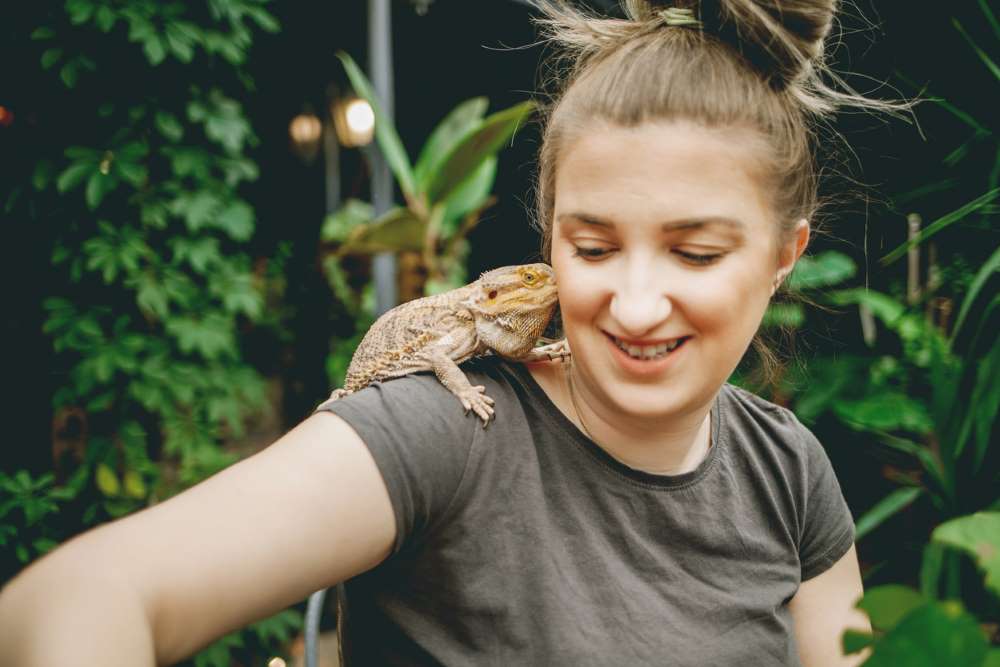
The bearded dragon gets their name from the spiky collars around their necks, which they expand to threaten other dragons or when they're upset or in love.
Bearded dragons are a popular choice for new reptile owners because they are big yet friendly and more adventurous than other reptiles. Beginner reptile owners like bearded dragons since they are easy to care for.
For a bearded dragon to survive as a pet, it must be kept warm and dry. It is the responsibility of every keeper to give the best possible care to these resilient creatures. And to keep them happy and healthy in the summer, here are some tips on taking care of them.
Feeding of Bearded Dragon in the Summer
Bearded dragons, like their human owners, can eat a wide variety of foods. Some are beneficial, while others are harmful. Bearded dragons devour insects and plant material.
Adult bearded dragons need roughly 80 percent vegetables, which includes salad greens and other veggies. The remaining 20 percent should be protein-rich foods like Dubia roaches, crickets, and super worms. Adults should have insects every day or every other day in tiny amounts. Adults are those above the age of 18 months. Around 12 months, introduce vegetables. They also need vitamins, calcium, and vitamin D. As they eat dubia roaches, this site will help you find the best dubia roaches for sale for your pet. They will provide you with the best dubia roaches available in the market.
Hatchlings under two months old should be fed insects five times daily while developing. From two-six months, they should be fed three-four times a day, and by six months, just three times daily. Then after 18 months, feedings should be reduced to twice daily. Calcium should be applied to insects and additional vitamin supplements for developing beardies.
Tips on Taking Care of Your Bearded Dragon in the Summer
Choose a heat lamp with UV light
A heat lamp with UV light helps prevent metabolic bone disease, and heat is essential to bring your exothermic pet's body temperature back to normal. In this way, vital activities like digestion are correctly simulated.
Use a Thermostat
If you don't already have one, you'll need to get one if you want to keep the heat lamp from overheating. Look for a thermostat with a dimming feature that has a wide range of settings. You can regulate the vivarium's temperature using the thermostat when it's hot outside. Bearded dragons may get dangerously overheated if they don't have somewhere to cool off.
It should be 38 to 42 degrees Celsius in the bright end of their vivarium for them to bask in, and 22 to 26 degrees Celsius in the dark end. First thing in the morning, turn on the heat lamp and the UV bulb. This will help your dragon get ready for the day.
Add fans to the Vents of the Vivarium
This will allow fresh air to come into the vivarium and draw out the stale air. This will keep the air moving in and out of the enclosure, which will help cool it down a little. Be sure to choose an appropriate bearded dragon tank size. Room fans can also help on hot days.
Add More Air to the Room
During the hot summer months, you might want to add more ventilation to your dragon's enclosure so that it doesn't get too hot and doesn't get too wet. Try adding some mesh panels to the walls of the enclosure.
Try Spraying Water
Spritzing your dragon's home in the morning, midday, and evening will help to keep it cool.
Bathing Bowls Filled with Water
Provide your bearded dragon with a big, shallow water dish that he or she can easily get into and out of it on his or her own. If they so wish, they may use this as a summer soaking tub to chill down in throughout the heat.
Build a Dragon ‘Cooling Chamber'
Build an environment for your dragon that is sheltered and damp so that it can cool off if necessary. If you want to cover it, you can find sphagnum moss online.
Substrate Digging
Bearded dragons are born to dig. Burrowing is also good for staying warm at night and cooling down in the middle of the day. It's also good for enrichment, hunting, and foraging. To get a good substrate, mix play sand and topsoil together.
How Long Do Bearded Dragons Live?
Bearded dragons have to deal with harsh environments in the wild. To survive, they must search and hunt for their own food, battle for their lives, and escape the various dangers. As a result, their lifespans are rather short. In the wild, a bearded dragon's lifespan is typically limited to three to eight years. As most dragons die around the ages of five or six, eight-year-old dragons are a rare sight.
Things are quite different for dragons in captivity, of course. An average domestic dragon has an easy and stress-free life. As a result, a domestic dragon's life expectancy is significantly increased in captivity. The typical lifetime of bearded dragons in captivity is between 8 and 15 years.
Conclusion
Keeping a bearded dragon is a pleasure compared to a chameleon or a turtle. As a result, they make wonderful companions for everyone, especially children.
A beardie doesn't have to be difficult to take care of, but taking one home should only be done after considering the care and expenditures involved. The benefits of owning one as a pet far outweigh the drawbacks, especially for kids. They appreciate human contact and are able to identify individuals, making it easier for you to connect with them. They'll be around for a long time if you take care of them properly.
FAQs
-
How do you take care of a bearded dragon in the summer?
Always keep an eye on your pet's temperature while it's outside in the summer. Make sure they have enough water to drink, give them plenty of baths, and provide shade if they're outside for an hour or two. When you leave your bearded dragon alone, make sure it has water.
-
How hot is too hot for bearded dragons?
While bearded dragons can endure a broad range of temperatures, it is better to keep the temperature of the hot zone between 100 and 110 degrees Fahrenheit. If your beardie isn't sitting in the hot spot, gaping openly, it isn't hot enough.
-
Can I put my bearded dragon outside in the sun?
In a largely sunny, warm, and low-humidity area, a bearded dragon can be housed outside. Keep them in a cage that is well-ventilated, has a tight cover, and has a variety of hiding spots and climbing areas. An indoor tank should also be put up for those occasions when it needs to be transported inside.



























